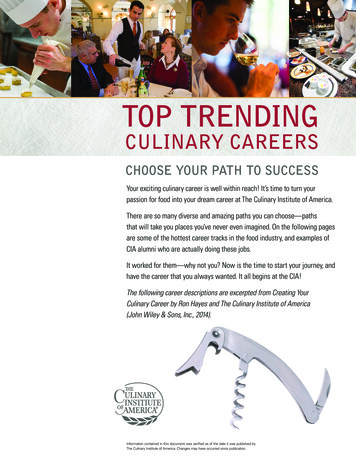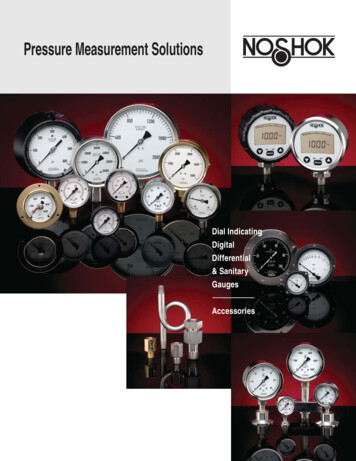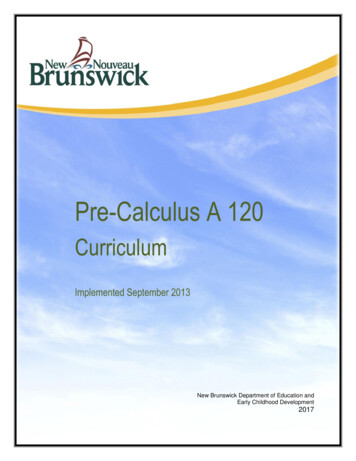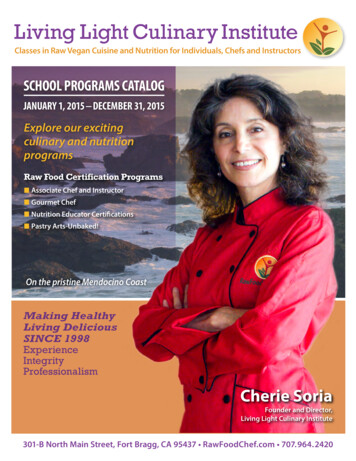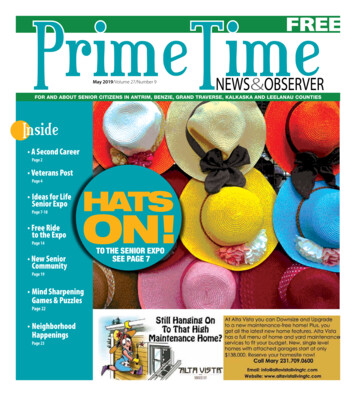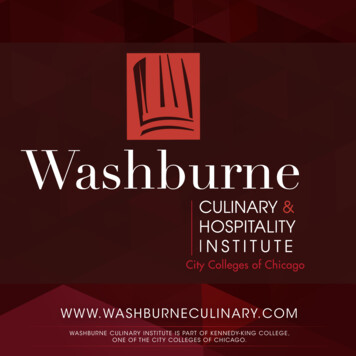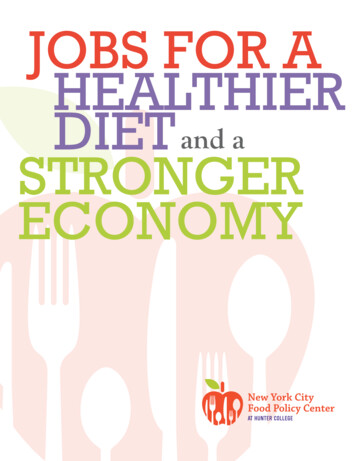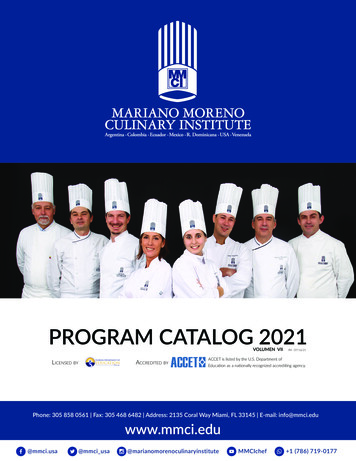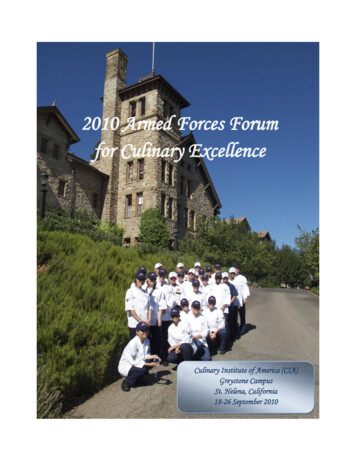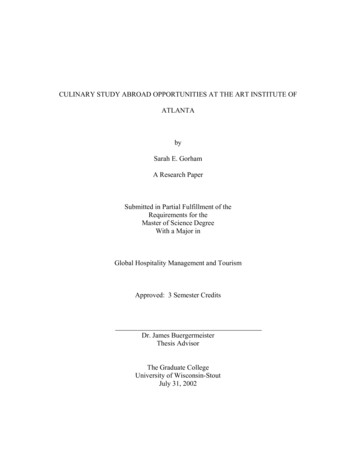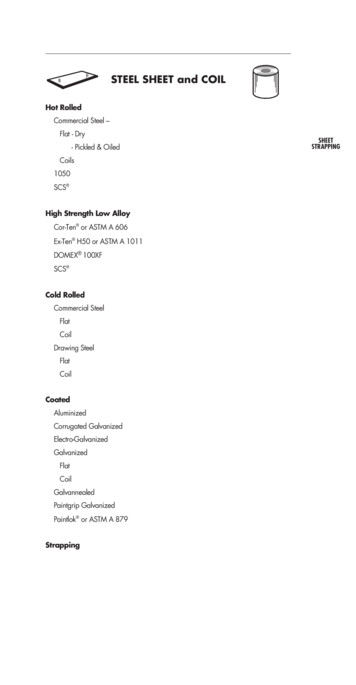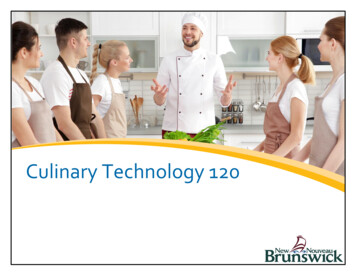
Transcription
Culinary Technology 120
2020Department of Education and Early Childhood DevelopmentCurriculum Branch
AcknowledgmentsThe Department of Education and Early Childhood Development of New Brunswick (EECD) gratefully acknowledges the contributions of thefollowing groups and individuals toward the development of the New Brunswick Culinary Technology 120 curriculum document: Culinary writing team members:o Robichaud, Colleen, Simonds High School; ASD-So Gallagher, Jacinta, Harbour View High School; ASD-So Holland, Tila, Miramichi Valley High School; ASD-No McDonnell, Debbie, James M. Hill High School; ASD-NChefs from Delta Fredericton, New BrunswickRepresentatives from New Brunswick Community College
Table of ContentsAcknowledgments .31.2.Introduction .51.1Mission and Vision of Educational System . 51.2New Brunswick Global Competencies . 5Pedagogical Components .62.1Pedagogical Guidelines . 6Diverse Cultural Perspectives . 6Universal Design for Learning . 6English as an Additional Language Curriculum. 72.2Pedagogical Guidelines . 8Assessment Practices . 8Formative Assessment . 9Summative Assessment . 9Cross Curricular Literacy . 93.Subject Specific Guidelines . 103.1Rationale . 103.2Course Description . 103.3Curriculum Organizers and Outcomes . 12Outcomes . 12Learning Outcomes Summary Chart . 134.Curriculum Outcomes . 15GCO 1 . 15
Students will examine employment practices and Occupational Health and Safety legislation. . 15GCO 2 . 18Students will identify the food service industry. . 18GCO 3 . 23Students will learn culinary methodology and equipment. 23GCO 4 . 25Students will explore culinary production through Enterprise Activities. . 255.Bibliography . 29Common Content . 29Subject Specific. 296.Appendices . 316.1 New Brunswick Global Competencies . 316.2 Universal Design for Learning (UDL) . 337.Resources . 36
1.Introduction1.1Mission and Vision of Educational SystemThe New Brunswick Department of Education and Early Childhood Development is dedicated to providing the best public educationsystem possible, wherein all students have a chance to achieve their academic best. The mission statement for New Brunswickschools is:Each student will develop the attributes needed to be a lifelong learner, to achieve personal fulfillment and to contribute to aproductive, just and democratic society.1.2New Brunswick Global CompetenciesNew Brunswick Global Competencies provide a consistent vision for the development of a coherent and relevant curriculum. Thestatements offer students clear goals and a powerful rationale for school work. They help ensure that provincial education systems’missions are met by design and intention. The New Brunswick Global Competencies statements are supported by curriculumoutcomes.New Brunswick Global Competencies are statements describing the knowledge, skills and attitudes expected of all students whograduate high school. Achievement of the New Brunswick Global Competencies prepares students to continue to learn throughouttheir lives. These Competencies describe expectations not in terms of individual school subjects but in terms of knowledge, skills andattitudes developed throughout the curriculum. They confirm that students need to make connections and develop abilities acrosssubject boundaries if they are to be ready to meet the shifting and ongoing demands of life, work and study today and in the future.See Appendix 6.1.5
2.Pedagogical Components2.1Pedagogical GuidelinesDiverse Cultural PerspectivesIt is important for teachers to recognize and honour the variety of cultures and experiences from which students are approachingtheir education and the world. It is also important for teachers to recognize their own biases and be careful not to assume levels ofphysical, social or academic competencies based on gender, culture, or socio-economic status.Each student’s culture will be unique, influenced by their community and family values, beliefs, and ways of viewing the world.Traditional aboriginal culture views the world in a much more holistic way than the dominant culture. Disciplines are taught asconnected to one another in a practical context, and learning takes place through active participation, oral communication andexperiences. Immigrant students may also be a source of alternate world views and cultural understandings. Cultural variation mayarise from the differences between urban, rural and isolated communities. It may also arise from the different value that familiesmay place on academics or athletics, books or media, theoretical or practical skills, or on community and church. Providing a varietyof teaching and assessment strategies to build on this diversity will provide an opportunity to enrich learning experiences for allstudents.Universal Design for LearningThe curriculum has been created to support the design of learning environments and lesson plans that meet the needs of alllearners. Specific examples to support Universal Design for Learning for this curriculum can be found in the appendices. ThePlanning for All Learners Framework will guide and inspire daily planning.See Appendix 6.26
English as an Additional Language CurriculumBeing the only official bilingual province, New Brunswick offers the opportunity for students to be educated in English and/or Frenchthrough our public education system. The EECD provides leadership from K-12 to assist educators and many stakeholders insupporting newcomers to New Brunswick. English language learners have opportunities to receive a range of instructional supportto improve their English language proficiency through an inclusive learning environment. EECD, in partnership with the educationaland wider communities offer a solid, quality education to families with school-aged children.7
2.2Pedagogical GuidelinesAssessment PracticesAssessment is the systematic gathering of information about what students know and are able to do. Student performance isassessed using the information collected during the evaluation process. Teachers use their professional skills, insight, knowledge,and specific criteria that they establish to make judgments about student performance in relation to learning outcomes. Studentsare also encouraged to monitor their own progress through self-assessment strategies, such as goal setting and rubrics.Research indicates that students benefit most when assessment is regular and ongoing and is used in the promotion of learning(Stiggins, 2008). This is often referred to as formative assessment. Evaluation is less effective if it is simply used at the end of aperiod of learning to determine a mark (summative evaluation).Summative evaluation is usually required in the form of an overall mark for a course of study, and rubrics are recommended for thistask. Sample rubrics templates are referenced in this document, acknowledging teachers may have alternative measures they willapply to evaluate student progress.Some examples of current assessment practices include: sentationsRole playsTechnology Applications Projects and InvestigationsChecklists/RubricsResponses to texts/activitiesReflective JournalsSelf and peer assessmentCareer PortfoliosProjects and Investigations8
Formative AssessmentResearch indicates that students benefit most when assessment is ongoing and is used in the promotion of learning (Stiggins, 2008).Formative assessment is a teaching and learning process that is frequent and interactive. A key component of formative assessmentis providing ongoing feedback to learners on their understanding and progress. Throughout the process adjustments are made toteaching and learning.Students should be encouraged to monitor their own progress through goal setting, co-constructing criteria and other self-and peerassessment strategies. As students become more involved in the assessment process, they are more engaged and motivated in theirlearning.Additional details can be found in the Formative Assessment document.Summative AssessmentSummative evaluation is used to inform the overall achievement for a reporting period for a course of study. Rubrics arerecommended to assist in this process. Sample rubrics templates are referenced in this document, acknowledging teachers mayhave alternative measures they will apply to evaluate student progress.For further reading in assessment and evaluation, visit the Department of Education and Early Childhood Development’s Assessmentand Evaluation site here.Cross Curricular LiteracyLiteracy occurs across learning contexts and within all subject areas. Opportunities to speak and listen, read and view, and write andrepresent are present every day -in and out of school.9
3.Subject Specific Guidelines3.1RationaleThe culinary industry is always in need of hard working, innovative, and creative individuals. Not only will students learn to cook forthemselves and their families, but they will also learn about food safety, the culinary industry, business and entrepreneurial skills,healthy food choices, local food security, and local food systems.This course will incorporate a hands-on approach of both project-based and experiential learning through enterprise activities usingthe interdisciplinary skills of observation, reflection, documentation, purposeful/intentional planning, goal setting, decision-making,and problem-solving.It is important to note that the purpose of this skilled trades course is to engage youth and to develop the skills necessary to follow acareer in the foodservice industry. This course is not a nutrition course; however, it will include important facts about healthy eatingand the evolution of healthier diets and options in today’s foodservice establishments. As part of this course, it should be noted thatsome choices in restaurant menus are not part of a regular healthy diet.3.2Course DescriptionCulinary Technology 120 is a continuation of Culinary Technology 110. The grade 12 skill sets include a review of skills learned ingrade 11, along with large equipment and food preparation skills with a focus on scratch cookery and current trends in nutrition andindustry. Culinary Technology 110 is a pre or co-requisite of Culinary Technology 120.Students will continue to study the theory of each skill and then be encouraged to practice those skills through enterprise activities.The overall aim of this course is to cultivate the need and desire of students to follow safe work practices and to develop thelanguage and work skills of the trade by being able to:10
explore employment skills and career awareness in Culinary Arts and associated trades (cook, baker, pastry chef, server,steward, and management); identify potential employment options looking at provincial statistics and industry projections; and, identify the certification and continued education available at colleges and universities, as well as an awareness of theCanadian Red Seal Certification Program and its professional designation (RSE).11
3.3Curriculum Organizers and OutcomesOutcomesThe New Brunswick Curriculum is stated in terms of general curriculum outcomes, specific curriculum outcomes and achievementindicators.General Curriculum Outcomes (GCO) are overarching statements about what students are expected to learn in each strand/substrand. The general curriculum outcome for each strand/sub-strand is the same throughout the grades.Specific Curriculum Outcomes (SCO) are statements that identify specific concepts and related skills underpinned by theunderstanding and knowledge attained by students as required for a given grade.12
Learning Outcomes Summary ChartGCO 1Students will examine employment practices and Occupational Health and Safety legislation.SCO 1.1Students will examine safe and legal workplace procedures.SCO 1.2Students will describe ethical and legal workplace behavior.SCO 1.3Students will examine employment opportunities, trades designations, and the Canadian Red SealCertification program.GCO 2Students will identify the food service industry.SCO 2.1Students will demonstrate food safety and sanitation.SCO 2.2Students will identify nutrition basics.SCO 2.3Students will demonstrate standard procedures in food service.SCO 2.4Students will identify and distinguish types of food service.SCO 2.5Students will identify the importance of menu planning and cost control.13
GCO 3Students will learn culinary methodology and equipment.SCO 3.1Students will identify and operate cooking equipment.SCO 3.2Students will explore cooking methodologies.GCO 4Students will learn culinary production through enterprise activities.SCO 4.1Students will prepare stocks, sauces, and soups.SCO 4.2Students will prepare meats, poultry, and game.SCO 4.3Students will prepare fish and shellfish.SCO 4.4Students will prepare plant-based proteins, vegetables, grains, and special dietary requirements.14
GCO 1: Students will examine employment practices and Occupational Health and Safety legislation.4.Curriculum OutcomesGCO 1Students will examine employment practices and Occupational Health and Safety legislation.SCO 1.1Students will examine safe and legal workplace procedures.Concepts and ContentNew Brunswick Construction Safety Association (NBCSA) onlinetraining courses in Workplace Hazardous Materials InformationSystems (WHMIS) and Safety Orientation to learn safe workpractices regarding WHMIS and the Employment Standards Act.Safe body mechanics (i.e. back safety, lifting, etc.).I Can – exemplars:I can identify potential consequences for unsafe procedures.I can interpret WHIMS symbols as identification for hazardous products.I can locate and properly use safety equipment.I can use Personal Protective Equipment (PPE).Basic First Aid.I can lockout and tag-out equipment with proper procedures.I can give examples of potential hazards with inappropriate clothing, footwear, andjewellery.I can understand and demonstrate back safety.I can use proper lifting techniques.I can demonstrate safe working loads.I can understand the importance of ergonomics and body mechanicsuse proper body position when using tools.I can respond to potential hazard or injury.ResourcesVideoWebsiteDocumentNew Brunswick Construction Safety Associationhttps://www.worksafenb.ca/15
GCO 1: Students will examine employment practices and Occupational Health and Safety legislation.SCO 1.2Students will describe ethical and legal workplace behavior.Concepts and ContentInteracting with customers’ property regarding appropriateresponsible resource management.I Can – exemplars:I can co-construct a description of appropriate workplace behaviorbased on my own and my peers’ experiences.Obligations to an owner (e.g. bonding, liability, privacy).Examine codes of ethics of organizations and -Conducthttp://www.cips.ca/ethics16
GCO 1: Students will examine employment practices and Occupational Health and Safety legislation.SCO 1.3Students will examine employment opportunities, trades designations, and the Canadian Red SealCertification program.Concepts and ContentJob descriptions and employment opportunities in the skilled trades.I Can – exemplars:I can discuss employment opportunities and statistics for tradespeople.Post secondary training options have grown in New Brunswick.I can explore post secondary options or apprenticeship programs fortrade training.Identify trades that are designated.I can identify a designated trade.The red seal certification program has a professional designation.I can explain the Red Seal Certification Program and its professionaldesignation nb/en/departments/postsecondary education training and ww.restaurantscanada.org/aboutus/17
GCO 2: Students will identify the food service industry.GCO 2Students will identify the food service industry.SCO 2.1Students will demonstrate food safety and sanitation.Concepts and ContentI Can – exemplars:Personal hygiene.I can demonstrate an understanding of how to apply sanitationprocedures and safe food handling to prevent food-borne illnesses.Prevention of cross-contamination and food-borne illnesses.Allergens.I can understand the nature of allergens and how contamination canoccur.I can control the exposure to allergens using approved communicationand food handling rantscanada.org/Food Allergy Canada: Free s/food-allergens/DocumentProfessional Cooking for Canadian Chefs (8thedition)18
GCO 2: Students will identify the food service industry.SCO 2.2Students will identify nutrition basics.Concepts and ContentNutrients, bodily function, calories, and healthy choices in cooking andmenu preparation.I Can – exemplars:I can list and describe the six categories of nutrients and explain theirfunction in the body.Calories, carbohydrates, fats, proteins, vitamins, minerals, and water.I can describe the relationship between calories and weight gain.I can describe guidelines for maintaining a healthy diet.I can describe ways that cooks can include nutrition principles intocooking and menu production.ResourcesVideoWebsiteCanada Food ssional Cooking for Canadian Chefs (8thedition)19
GCO 2: Students will identify the food service industry.SCO 2.3Students will demonstrate Standard Procedures in food service.I Can – exemplars:I can explain the rationale of standardization as it applies to foodservice.Concepts and ContentStandardized recipes.Measuring techniques.I can identify and demonstrate the use of standard procedures in foodpreparation: recipes/formulas, measuring, portion control,terminology, tools, utensils, and small equipment.Portion control techniques.Small tools, utensils and appliances.I can demonstrate proper table setting techniques and table service.Table setting and service.ResourcesVideoWebsiteDocumentProfessional Cooking for Canadian Chefs (8thedition)20
GCO 2: Students will identify the food service industry.SCO 2.4Students will identify/select and distinguish types of food service.I Can – exemplars:I can distinguish between commercial, institutional (non-commercial),and catering food service.Concepts and ContentCommercial, institutional and catering services.Profit versus not-for-profit business.Organization of work space and staff, e.g. "front of the house" and "back of thehouse" duties.Training, experience, and qualities needed for this type of work.I can develop an understanding of how the food service operation isorganized, e.g. "front of the house" or service opportunities, "back ofthe house" or production opportunities, skill/training level.I can identify the qualities needed to work in this industry.Advantages and disadvantages of careers in food service.I can see connections between the rewards and demands of foodservice work.Commercial kitchen layout and design: list and identify the stations used in the food servicekitchen.simplify work through the efficient use of food, time,equipment, energy, and personnel.I can discuss and recognize the rationale behind the layout of acommercial kitchen design: type of food service establishment,amount of available space, menu items to be prepared, number ofmeals to be served, and organization within work stations.I can examine terminology necessary to create an efficient workenvironment: work simplification, work flow, production schedules,time management, and time schedules.I can view, discuss, and create samples of production schedules.I can discuss and consider the importance of teamwork to the overallsuccess of a business.ResourcesVideoWebsiteRestaurants ofessional Cooking for Canadian Chefs (8thedition)21
GCO 2: Students will identify the food service industry.SCO 2.5Students will identify the importance of menu planning and cost control.I Can – exemplars:I can identify the two main types of menus: fixed and cycle.Concepts and ContentTypes of menus: fixed and cycle.Influences on restaurant menus, culture, heritage, and community.Principles of menu planning, nutrition, and balance.I can identify the influences on menus and understand the impact ofnutrition.I can identify the principles of menu planning: nutrition, variety,balance, flexibility, and truthfulness.The menu as a selling tool.Influences on menu item pricing.I can understand how board, spoken, and printed menus are used asselling tools.I can understand influences on menu pricing: operating cost, labourcost, and food costI can apply principles of food cost and selling price of a recipe or menuitem.I can calculate the cost of a given recipe or menu item.ResourcesVideoWebsiteOnline and local restaurant menus are a goodresourceDocumentProfessional Cooking for Canadian Chefs (8thedition)Restaurants Canadahttps://www.restaurantscanada.org/22
GCO 3: Students will learn culinary methodology and equipment.GCO 3Students will learn culinary methodology and equipment.SCO 3.1Students will identify and operate cooking equipment.Concepts and ContentI Can – exemplars:Review small wares and service equipment.I can use available resources to safely use, care for, and clean largeequipment in food service operations, i.e. griddles, broiler, fryer,range, warmers, convection equipment, sous vide, microwave, andcleaning equipment.Large kitchen equipment, operation, cleaning, and use.Construction, fuel source, and connections to basic concepts in foodscience.I can identify types of equipment and common operating principles,such as fuel type, and special properties, i.e. gas, electric, induction,convection, and micro-air impingement.I can consider the effects of heat on foods, heat transfer, landcanada.ca/DocumentChapter 6 of Professional Cooking forCanadian Chefs (8th obart.ca/https://www.turbochef.com/23
GCO 3: Students will learn culinary methodology and equipment.SCO 3.2Students will explore cooking methodologies.Concepts and ContentConventional cooking methods: dry heat: roast and bake, barbeque, broil, grill, griddle and panbroil, sauté, pan-fry, deep fry. moist heat: poach, simmer, boil, steam, braise(stewing).I Can – exemplars:I can experiment with and evaluate different cooking methods todetermine the positive and negative attributes of each.I can choose the appropriate cooking and preparation method for theproduct being cooked (texture and vitamin retention).Microwave cooking.I can identify modern cooking methods using precision cookery andmolecular gastronomy.Sous Vide or precision cooking.Molecular Gastronomy: nontraditional thickeners; foams, froths, andbubbles; gels; drying and powdering; spherification/reversespherification.Flavor building principles and flavor profiles: purpose, harmony, contrast and balance. classic pairings. seasoning and flavorings.ResourcesVideoWebsiteI can develop the ability to work with various flavor profilesconsidering purpose, harmony, contrast, and balance.I can consider flavorings and seasonings to integrate in foodproduction (condiments, herbs and spices).DocumentProfessional Cooking for Canadian Chefs (8thedition)24
GCO 4: Students will explore culinary production through Enterprise Activities.GCO 4Students will explore culinary production through Enterprise Activities.SCO 4.1Students will prepare stocks, sauces, and soups.Concepts and ContentI Can – exemplars:Stocks: meat, poultry, game, fish, and vegetable.I can produce various stocks using proper methods for each fromresources available (meat, poultry, game, fish, and vegetable).Quality, flavour, and health benefits of enriched broth as well as wastereduction/value added product.Soups: thick, clear, and purees m
Culinary Technology 120 is a continuation of Culinary Technology 110. The grade 12 skill sets include a review of skills learned in grade 11, along with large equipment and food preparation skills with a focus on scratch cookery and current trends in nutrition and industry. Culinary Technology 110 is a pre or
